Seal Released Off Monmouth County Coastline

Recently, an adult 600-pound plus Grey Seal was released back into the Atlantic Ocean at Sandy Hook. The seal was found sick and malnourished in February 2013 near Seaside Park. After several months of care and treatment from staff at the Marine Mammal Stranding Center in Brigantine, NJ, the seal was healthy enough to send back into the wild to be free. The seal was released at Sandy Hook because of its location as the northern most spot along the Jersey Shore and nearest to New England and the Canadian Maritime provinces where the western Atlantic population of Grey Seals often gathers to breed, feed and haul out to relax during the summer. (posted 6/12/2013)
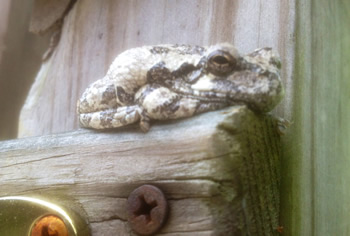
The trilling call of the male Northern Gray Tree Frog can be heard on mild, humid nights from late April to August when the temperature rises above 60 F. Tadpole development is quite rapid and the bright-green juvenile frogs appear at the edges of their birth pond in mid-July. The almost identical looking Southern Gray Tree Frog is endangered due to habitat loss. The Southern Gray has a quicker, shorter, and higher pitched trill. Generally the Southern Tree Frog is not found in Monmouth County. (posted 5/22/13)
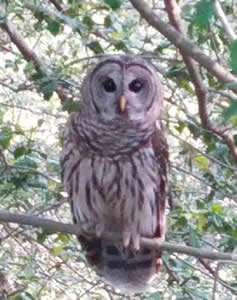
This Barred Owl was photographed in Hartshorne Woods as it flew out to investigate a man washing his car. The Barred Owl has become a rare sight in Monmouth County due to habitat encroachment and destruction. It was placed on the NJ Threatened Species List in 1979. The Barred Owl is known by many colloquial names including Swamp Owl, Hooter Owl, Eight Hooter, Rain Owl, Wood Owl and Striped Owl. It has well established populations in remote wetland areas and the highlands areas of the state.
The Barred Owl preys on small mammals but may include reptiles, amphibians, insects or small birds in its diet. It has even been observed wading into water to catch fish. This owl can often be heard calling on a cloudy day and is sometimes seen hunting during the day. The Barred Owl has brown eyes, a wing span of 42 inches, stands 21 inches high and weighs 1.6 pounds. (posted 5/21/13)
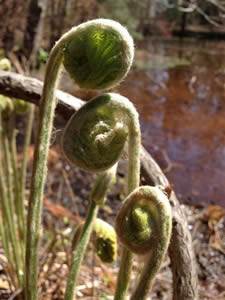
Spring is here and the sight of fern fiddleheads along the pond at Huber Woods Park is just another reassuring sign. These fiddleheads are the beginning of the Cinnamon Fern. Cinnamon Ferns are large ferns native to the Americas and Eastern Asia; their leaves grow up to six feet long and a foot wide. They grow in large clumps in moist woods, marshes, wet ditches, and stream banks. This fern often grows alongside other plants, such as Highbush Blueberry and Greenbrier. In early spring, new young leaves start to grow. They look like a skinny stem, which uncoils into a leaf. These young skinny structures are called "fiddleheads." Fiddleheads are eaten by white-tailed deer and other animals. Cinnamon Fern provides good cover and protection for small animals such as squirrels, toads, birds, snakes and insects. (posted 4/22/2013)
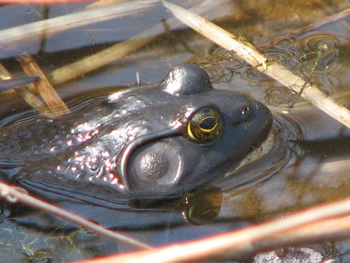
Bullfrogs are found throughout the state in any permanent body of freshwater; however, they are not found in the core Pine Barrens due to area's naturally acidic water. They are considered an invasive species in New Jersey and have displaced our native Carpenter Frogs and the threatened Pine Barrens Treefrog.
Bullfrogs spend two years as tadpoles. Males and females can be distinguished by comparing the size of their eye relative to their eardrum (tympanum). In females, the eardrum is the same size of the eye, or smaller, and in the male the eardrum is much larger than the eye. The males call from around April through July with a bellowing jug-o-rum. (posted 4/17/13)
Bluebells Blooming at Historic Walnford, Upper Freehold

The bluebells are blooming at Historic Walnford, Upper Freehold! These colorful wildflowers can be found along the banks of Crosswicks Creek. Even better, there's a good chance that the flowers will be at their peak for the Bluebell Festival on Sunday, April 14th.
We are very excited to announce that we have two eaglets at the Manasquan Reservoir! Here are a few eaglet milestones:
- Hatching began March 4th.
- At 4 to 5 weeks eaglets can stand and feed themselves.
- By 6 weeks they are almost as large as their parents and they take their first flights around 10 to 13 weeks.
Come visit us at the Environmental Center to learn more about our eagles and other wildlife. (posted 4/9/13)
Wood Frogs and Spring Peepers Calling
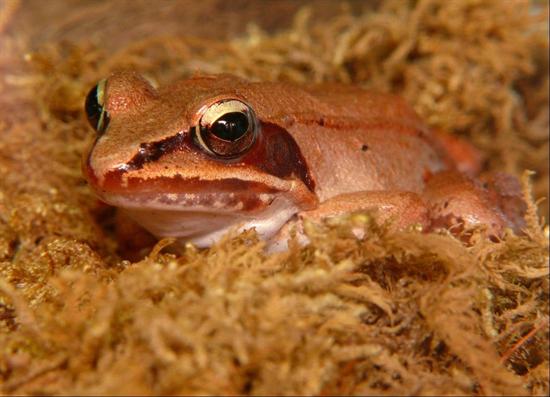
Wood Frog
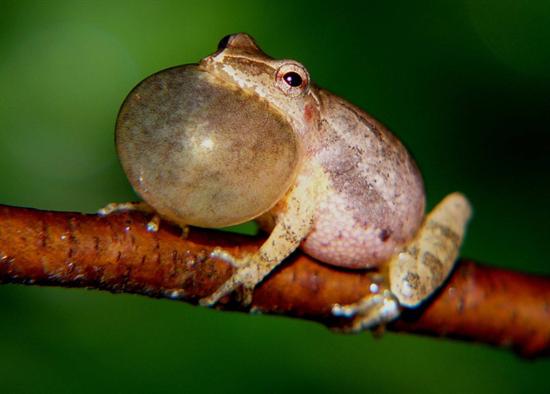
Spring Peeper
Spring is in the air and so are the calls of wood frogs and spring peepers. These amphibians begin calling in mid-March, but wood frogs may call as early as February. Wood frogs breed only in vernal wetlands. These temporary wetlands form from spring rains and snow and are vital for several amphibian species. Spring peepers also call from vernal wetlands, but are not as particular and will use any body of freshwater to breed. The call of the wood frog is a duck-like quacking and the tiny spring peepers, as their name implies, loudly peep. (posted 3/13/13)

One of our Park System Naturalists spotted this Silver-haired bat hanging on the side of one of the out buildings in the Timolat Section of Huber Woods recently. The bat appeared to be in great condition and was taking advantage of the warmth of the building's southern exposure. Silver-haired Bats can be quite common when migrating and will be found on the sides of buildings, railroad ties and fence posts. This bat is a tree bat and it usually does not roost in large colonies. It typically roosts under loose tree bark but will also use woodpecker holes and bird nests. The Silver-haired bat was not affected by the White-nose Syndrome - a fungus that has devastated cave bats. This year the NJ Bat Sanctuary has experienced an increase in calls regarding the Silver-haired bat and many of the reports are from Monmouth County. These are medium sized bats with a wing span of 11 to 13 inches and weigh .3 to .4 ounces. (posted 3/11/13)
Eagle Hatching has begun! Hatching was officially called March 4th. We'll be waiting to see how many heads pop up in a week or two. Check back here for more updates. (posted 3/5/13)
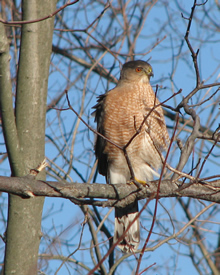
This beautiful adult Cooper's Hawk was seen near the Environmental Center recently. Cooper's Hawks belong to a group of woodland hawks known as accipiters that specialize in hunting small birds. The Cooper's Hawk is crow sized and fits between the smaller, but similar, Sharp-shinned Hawk and larger Northern goshawk. During the breeding season, Cooper's Hawks are found in upland, riparian or freshwater wetland forests. For several seasons, a pair had a nest at the reservoir. The Cooper's Hawk was recently reclassified from Threatened to Special Concern due to an increase in the breeding population. However, this good news must be tempered by the continued threat posed by the loss of the large, contiguous forests it needs for breeding and hunting. (posted 1/30/13)
On Saturday, January 26th the bald eagle pair at the Manasquan Reservoir began to incubate eggs. For the next 35 days, on average, one of the adults will always be sitting on the eggs until they hatch around March 1st. Check back for more updates, or visit the Manasquan Reservoir Environmental Center. (posted 1/30/13)
White-Winged Crossbill and Red Crossbill
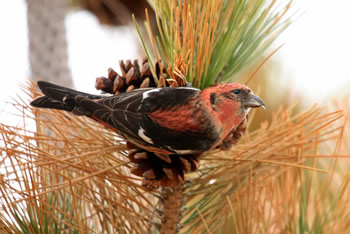
White-Winged Crossbills
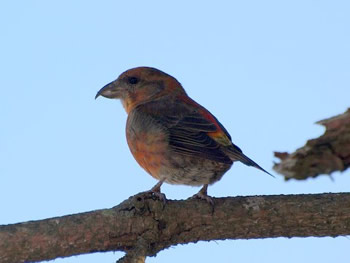
Red Crossbills
White-Winged Crossbills and Red Crossbills have recently been observed feeding in the Japanese Pines at Seven Presidents Oceanfront Park and in the pines at Thompson Park (White-winged). These finches breed in Canada usually only visiting NJ in the winter and not all that often. They have specialized bills for removing seeds from pine cones. The upper and lower mandibles actually overlap, side to side, enabling the bird to easily remove the seeds. Photo by Jeff Lee (posted 1/25/13)
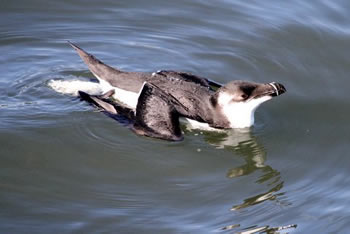
Razorbills have been observed up and down the East Coast this year with many sightings as far south as Florida. Several Razorbills have been seen from the beach at Seven Presidents Oceanfront Park this month. These small pelagic birds weigh about 1.5 pounds and are ocean dwellers. Razorbills venture onto land to breed along the cliffs and rocky islands of the northern most reaches of North America's east coast. However, about 65% to 70% of the world Razorbill population breeds in Greenland. They mate for life and usually produce one chick per year. Razorbills feed on capelin (a type of smelt), sand lance, juvenile cod, sprats and herring. Most feeding takes place down to depths of 80 feet but they can dive as deep as 400 ft. Photo by Jeff Lee (posted 1/25/13)
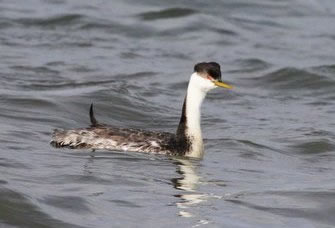
A Western Grebe was reported off the beach at Seven Presidents Oceanfront Park this month. This species, though still rare in New Jersey, is beginning to be a yearly winter visitor to the Jersey Shore with sightings nearly every year since 2002. The dull yellow bill, dark face, and long slender white neck are distinctive. Weighing in around 3.5 pounds and with a wing span of 24 inches, it is the largest Grebe in North America. This bird breeds in huge colonies on large lakes and marshes in the western part of the United States. They are known for a spectacular courtship dance that takes place in the open water. Photo by Jeff Lee (posted 1/25/13)
Pink-footed Goose
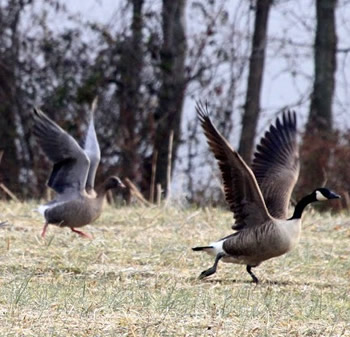
The Pink-footed Goose is a rare visitor to New Jersey. This one was photographed in Mercer County during the Park System's last Winter Birding Expedition bus trip on January 9. It has since been seen at Assunpink Reservoir and other locations in Monmouth County. The Pink-foot breeds in Greenland and Iceland, and very seldom ventures to New Jersey. The state's first sighting was in March of 2007. The Pink-footed Goose population is on the rise largely due to increased protection from hunting on its wintering grounds. This Pink-footed Goose (left) is next to a Canada Goose. Photo by Jeff Lee (posted 1/25/13)
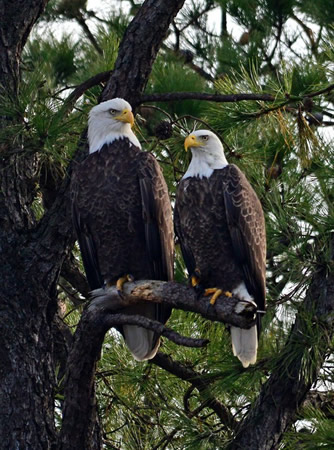
The Bald Eagles at the Manasquan Reservoir have been busy. They have recently built a new nest about 150 yards east of their old nesting location. Historically, this eagle pair has begun their egg incubation during the first and second week of January. Eagle watchers at the Manasquan Reservoir are anxiously awaiting the event. Winter is one of the best times to view the eagles at the Manasquan Reservoir located in Howell, NJ. Drop by the Environmental Center for all the up-to-date information. (posted 1/10/13)
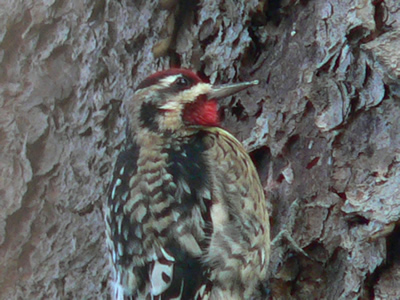
This medium sized, well-camouflaged woodpecker is a transient in Monmouth County and seen during the spring and fall migrations. Occasionally, some will stay over for the winter. This male was photographed this week at Huber Woods in a stand of spruce trees. The females have a white throat but otherwise they are very similar to the males. Sapsuckers do not actually suck the sap from trees, but they lap it up with their tongues from the holes that they drill. The holes are generally drilled in parallel rows. Insects will take advantage of the sap oozing from the holes and the sapsucker will readily eat the insects that may become stuck. Hummingbirds have been observed taking advantage of the sapsuckers' handiwork as well. There are over a 1000 species of trees that the sapsuckers have drilled but they seem to prefer birches and maples. (posted 1/03/13)
Northern Saw-whet Owl
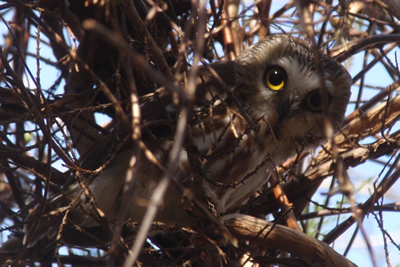
One of our Park Rangers discovered this rarely seen winter visitor and one of our Park System Naturalists was able to snap a picture of this shy creature. With a wing span of only 17 inches and a length of 8 inches, the Saw-whet Owl is slightly smaller than the Eastern Screech Owl but, at 2.8 oz., weighs less than half as much. These nocturnal birds feed almost entirely on small mammals with deer mice being the preferred prey, followed by shrews and voles. They will also eat small birds, frogs and insects. The Northern Saw-whet inhabits deciduous and coniferous forests and is a cavity nester. The owl's name comes from the "skiew" call that it makes when alarmed. This noise has a resemblance to the whetting of a saw. (posted 1/04/13)
Back to Nature Now